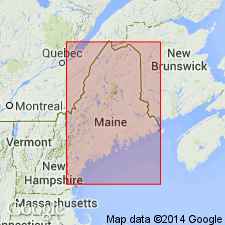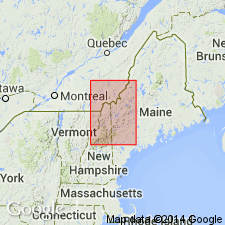
- Usage in publication:
-
- Boil Mountain Complex*
- Modifications:
-
- Named
- Dominant lithology:
-
- Serpentinite
- Pyroxenite
- Gabbro
- Tonalite
- AAPG geologic province:
-
- New England province
Summary:
Plutonic rocks of the ophiolite sequence in central-western Maine are here named the Boil Mountain Complex. It consists of plutonic rocks including serpentinite, pyroxenite, gabbro, epidiorite, and tonalite. The complex is extensively altered by tectonism and metamorphism, especially to the southwest, where segments of serpentinite have been remobilized to form diapiric serpentinite. At the base, epidiorite, gabbro, and serpentinite are in sharp, concordant contact with the Chain Lakes massif. Along the southeastern edge, probably the stratigraphic top, tonalite is in undisturbed contact with greenstone of the Jim Pond Formation. Age is Cambrian(?) and Early Ordovician(?).
Source: GNU records (USGS DDS-6; Reston GNULEX).

- Usage in publication:
-
- Boil Mountain Complex*
- Modifications:
-
- Age modified
- Geochronologic dating
- AAPG geologic province:
-
- New England province
Summary:
Age of Boil Mountain Complex changed to Cambrian(?) based on trondhjemite dated at about 520 Ma by Eisenberg (1982) using U-Pb methods, but date is considered with large uncertainty. An Ordovician age, though unlikely, cannot be ruled out, but is not assigned here. Similarity of isotopic data with that from Jim Pond Formation permit the interpretation that felsic igneous rocks of both Boil Mountain Complex and Jim Pond are coeval, as proposed by Boudette (1982).
Source: GNU records (USGS DDS-6; Reston GNULEX).
For more information, please contact Nancy Stamm, Geologic Names Committee Secretary.
Asterisk (*) indicates published by U.S. Geological Survey authors.
"No current usage" (†) implies that a name has been abandoned or has fallen into disuse. Former usage and, if known, replacement name given in parentheses ( ).
Slash (/) indicates name conflicts with nomenclatural guidelines (CSN, 1933; ACSN, 1961, 1970; NACSN, 1983, 2005, 2021). May be explained within brackets ([ ]).

